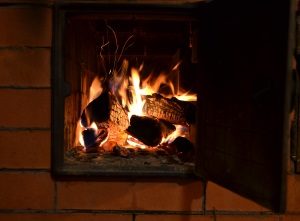Burning Firewood Sounds And The Reason Behind Them
Don’t you love to just sometimes sit back behind a fireplace or a wood stove and listen to those pops, crackles and hisses burning firewood makes?
The sounds might sure be pleasing, but if they’re louder than usual there might be a problem with firewood your’e burning.
Why does burning firewood make sounds?

To put it simply, the reason why firewood makes all these sounds when burnt is because it has some water content inside of it.
Even the most seasoned firewood usually makes some sort of sound when burnt, and that’s because it still has some water inside of it, as properly seasoned wood has a water content below 20%.
The problem comes when the sounds are more fierce than normal, which is usually because the firewood is simply unseasoned.
It goes without saying that you should not burn unseasoned wood in a wood stove, fireplace or a furnace.
What happens if you burn unseasoned firewood?
Burning unseasoned firewood creates unnecessary amount of creosote which sticks to the walls of a chimney, and if the chimney is not cleaned frequently, it might cause a chimney fire.
Besides that, burning green wood is inefficient as it requires more work to start burning, and produces little amount of heat.
How to properly season firewood
Firewood is seasoned by letting it dry for a specific amount of time, depending on which type of wood it is – softwoods require anywhere from 6 to 12 months of drying, while hardwoods like Douglas Fir might need 1 to 2 years.
One of the best times to start preparing firewood for the coming winter or any other time is the summer, as firewood dries better in warmer conditions, especially with extra sunlight.
How to Stack Firewood
Firewood won’t season after being thrown in a pile, so you have to stack it. There are many ways to do it, but one of the most common is by stacking it vertically.
Start by placing some wooden material on the ground where you’ll be stacking your firewood, as the goal here is to keep it off the ground to reduce rotting; if you live in a termite active area, you might consider even elevating the whole stack off the ground on things like cinder blocks, as you don’t want them to infest your firewood.
Stack the firewood along the length of wood you have placed on the ground – the stack length, height and the amount of them depends on the amount of firewood you have.

Stacking firewood is like solving a jigsaw puzzle – some pieces of wood are going to be thinner than others, so make sure you utilize all the space and don’t leave too much opening, but remember to still leave some to provide ventilation.
Eventually the firewood on the ends of your stack will start to roll down as there are no supports holding it back. Corners can be made from the same firewood – just stack it in a criss-cross pattern to make a pillar.
The stacks should be covered to protect them from rain. You could just use some tarp to do so, or with sheets of metal, just make sure to cover the top only.
How to know if firewood is seasoned
As i said before, the rule of thumb is that firewood is seasoned when it’s moisture content is below 20%.
Seasoned firewood is a lot lighter than green one. It also has cracks, and the bark peels of easily.
The color of seasoned firewood is a lot more bland. If you hit two pieces of seasoned wood together, it should make more of a hollow sound.
If you really want to make sure you have properly seasoned wood, you can simply purchase a firewood moisture meter to find that out.